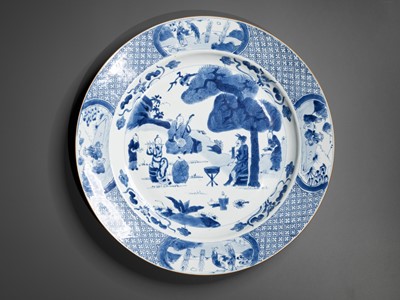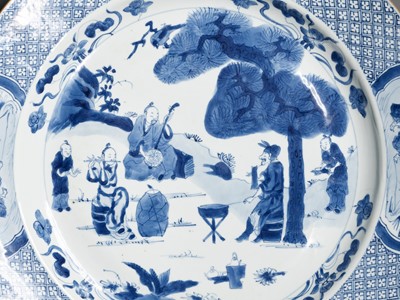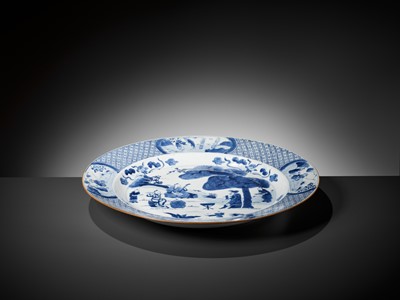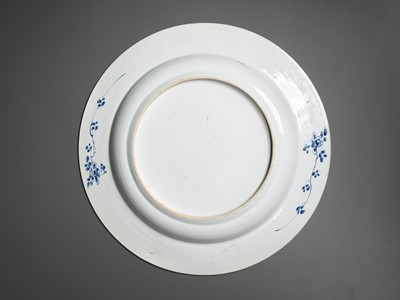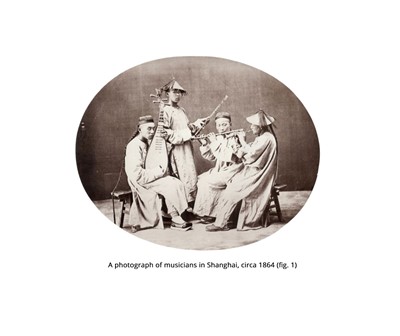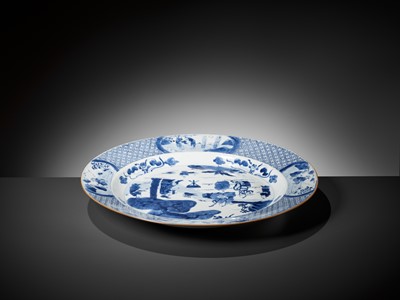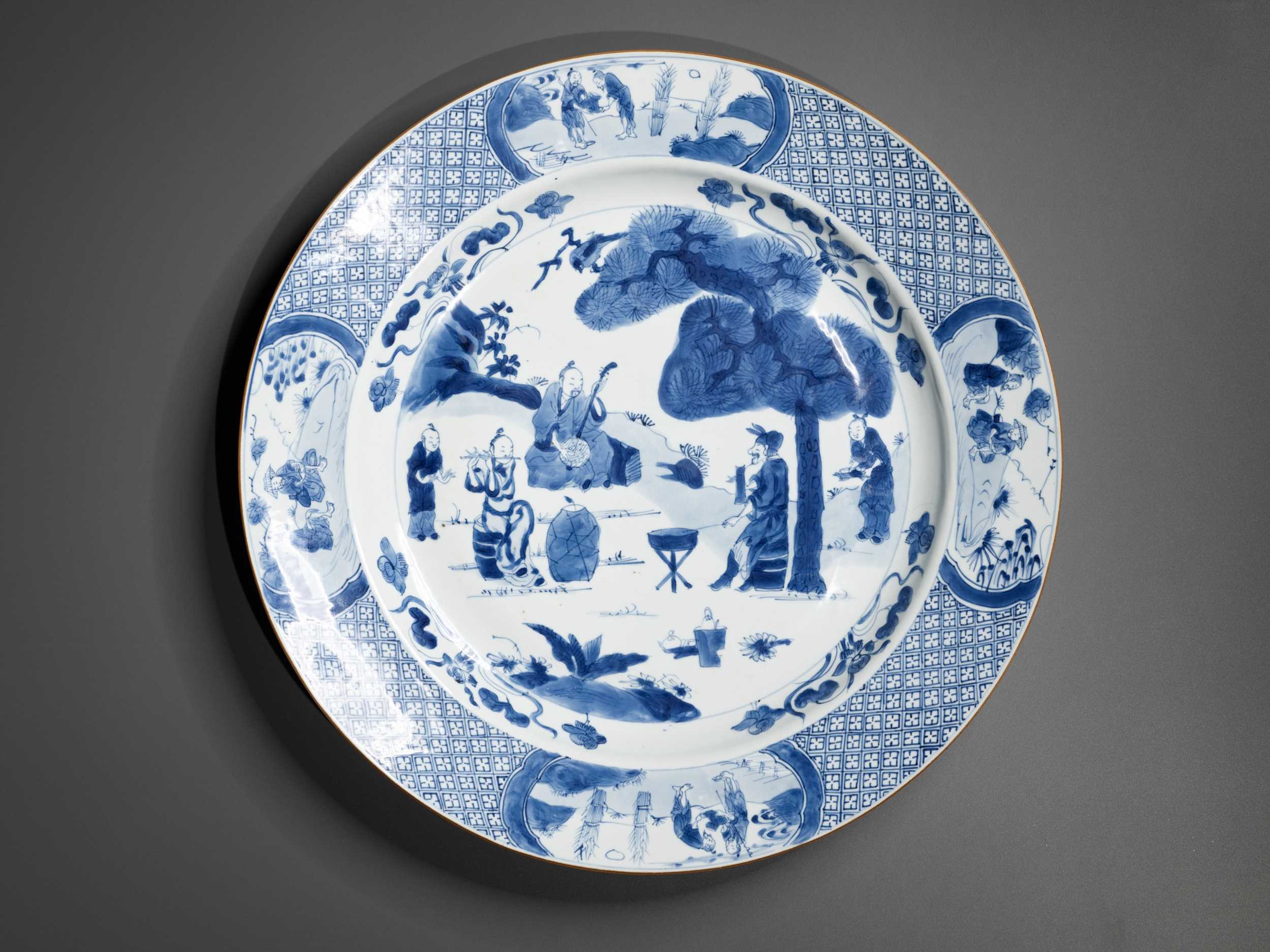10th Mar, 2022 10:00
DAY 1 - TWO-DAY AUCTION - Fine Chinese Art / 中國藝術集珍 / Buddhism & Hinduism
194
A BLUE AND WHITE ‘MUSICIANS’ DISH, KANGXI PERIOD
康熙時期青花開光樂者場景大盤
Sold for €2,275
including Buyer's Premium
China, 1662-1722. The shallow rounded sides rising from a short tapered foot to a wide everted rim, the broad floor filled with Daoist musicians and their attendants in the shade of a pine tree at a hillside, surrounded by a band of lotus flowers and Daoist emblems to the short cavetto, the gently sloping wide rim with additional Daoist figures framed within reserves against a geometric patterned ground.
Provenance: Belgian trade, by repute from a local private collection.
Condition: Fine condition with minor old wear and firing flaws, the rim with two hairlines, minuscule nicks to the foot.
Weight: 1,412 g
Dimensions: Diameter 39.5 cm
It is interesting to note that the Chinese musical tradition remained quite stable throughout the Qing dynasty before the New Culture Movement, as evidenced by the many similarities between the painting on the present dish and the musicians pictured in an old photograph taken in Shanghai during the 1860s (figure 1). The first major and well-documented flowering of Chinese music was for the qin during the Tang dynasty (618-907 AD), although this instrument is known to have been played already since before the Han period. Through succeeding dynasties over thousands of years, Chinese musicians developed a large assortment of different instruments and playing styles, including court, folk, and religious music as well as instrumental, opera, storytelling, and many other kinds. A wide variety of these instruments, such as guzheng and dizi, are indigenous, although many popular traditional musical instruments were introduced from Central Asia, such as the erhu and pipa. Musical instruments were traditionally classified into eight categories known as bayin. Traditional music in China is played on solo instruments or in small ensembles of plucked and bowed stringed instruments, flutes, and various cymbals, gongs, and drums. The scale is pentatonic. Bamboo pipes and qin are among the oldest known musical instruments from China.
康熙時期青花開光樂者場景大盤
中國,1662-1722年。折沿,斜圓腹,中央開光青花描繪文人園中松下奏樂賞玩場景;折沿上錦地開光描繪農家樂;斜腹上蓮紋。
來源:比利時古玩市場,據説來自當地私人收藏。
品相:狀況良好,有輕微的磨損和燒製瑕疵,邊緣有兩條細裂紋,足部有微小的刻痕。
重量:1,412 克
尺寸:直徑39.5厘米
China, 1662-1722. The shallow rounded sides rising from a short tapered foot to a wide everted rim, the broad floor filled with Daoist musicians and their attendants in the shade of a pine tree at a hillside, surrounded by a band of lotus flowers and Daoist emblems to the short cavetto, the gently sloping wide rim with additional Daoist figures framed within reserves against a geometric patterned ground.
Provenance: Belgian trade, by repute from a local private collection.
Condition: Fine condition with minor old wear and firing flaws, the rim with two hairlines, minuscule nicks to the foot.
Weight: 1,412 g
Dimensions: Diameter 39.5 cm
It is interesting to note that the Chinese musical tradition remained quite stable throughout the Qing dynasty before the New Culture Movement, as evidenced by the many similarities between the painting on the present dish and the musicians pictured in an old photograph taken in Shanghai during the 1860s (figure 1). The first major and well-documented flowering of Chinese music was for the qin during the Tang dynasty (618-907 AD), although this instrument is known to have been played already since before the Han period. Through succeeding dynasties over thousands of years, Chinese musicians developed a large assortment of different instruments and playing styles, including court, folk, and religious music as well as instrumental, opera, storytelling, and many other kinds. A wide variety of these instruments, such as guzheng and dizi, are indigenous, although many popular traditional musical instruments were introduced from Central Asia, such as the erhu and pipa. Musical instruments were traditionally classified into eight categories known as bayin. Traditional music in China is played on solo instruments or in small ensembles of plucked and bowed stringed instruments, flutes, and various cymbals, gongs, and drums. The scale is pentatonic. Bamboo pipes and qin are among the oldest known musical instruments from China.
康熙時期青花開光樂者場景大盤
中國,1662-1722年。折沿,斜圓腹,中央開光青花描繪文人園中松下奏樂賞玩場景;折沿上錦地開光描繪農家樂;斜腹上蓮紋。
來源:比利時古玩市場,據説來自當地私人收藏。
品相:狀況良好,有輕微的磨損和燒製瑕疵,邊緣有兩條細裂紋,足部有微小的刻痕。
重量:1,412 克
尺寸:直徑39.5厘米
Zacke Live Online Bidding
Our online bidding platform makes it easier than ever to bid in our auctions! When you bid through our website, you can take advantage of our premium buyer's terms without incurring any additional online bidding surcharges.
To bid live online, you'll need to create an online account. Once your account is created and your identity is verified, you can register to bid in an auction up to 12 hours before the auction begins.
Intended Spend and Bid Limits
When you register to bid in an online auction, you will need to share your intended maximum spending budget for the auction. We will then review your intended spend and set a bid limit for you. Once you have pre-registered for a live online auction, you can see your intended spend and bid limit by going to 'Account Settings' and clicking on 'Live Bidding Registrations'.
Your bid limit will be the maximum amount you can bid during the auction. Your bid limit is for the hammer price and is not affected by the buyer’s premium and VAT. For example, if you have a bid limit of €1,000 and place two winning bids for €300 and €200, then you will only be able to bid €500 for the rest of the auction. If you try to place a bid that is higher than €500, you will not be able to do so.
Online Absentee and Telephone Bids
You can now leave absentee and telephone bids on our website!
Absentee Bidding
Once you've created an account and your identity is verified, you can leave your absentee bid directly on the lot page. We will contact you when your bids have been confirmed.
Telephone Bidding
Once you've created an account and your identity is verified, you can leave telephone bids online. We will contact you when your bids have been confirmed.
Classic Absentee and Telephone Bidding Form
You can still submit absentee and telephone bids by email or fax if you prefer. Simply fill out the Absentee Bidding/Telephone bidding form and return it to us by email at office@zacke.at or by fax at +43 (1) 532 04 52 20. You can download the PDF from our Upcoming Auctions page.
How-To Guides
How to Create Your Personal Zacke Account
How to Register to Bid on Zacke Live
How to Leave Absentee Bids Online
How to Leave Telephone Bids Online
中文版本的操作指南
创建新账号
注册Zacke Live在线直播竞拍(免平台费)
缺席投标和电话投标
Third-Party Bidding
We partner with best-in-class third-party partners to make it easy for you to bid online in the channel of your choice. Please note that if you bid with one of our third-party online partners, then there will be a live bidding surcharge on top of your final purchase price. You can find all of our fees here. Here's a full list of our third-party partners:
- 51 Bid Live
- EpaiLive
- ArtFoxLive
- Invaluable
- LiveAuctioneers
- the-saleroom
- lot-tissimo
- Drouot
Please note that we place different auctions on different platforms. For example, in general, we only place Chinese art auctions on 51 Bid Live.
Bidding in Person
You must register to bid in person and will be assigned a paddle at the auction. Please contact us at office@zacke.at or +43 (1) 532 04 52 for the latest local health and safety guidelines.
